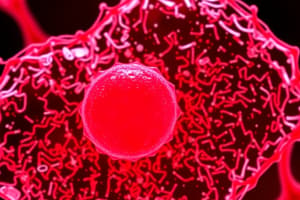Podcast
Questions and Answers
What is the primary function of the mitochondria in a cell?
What is the primary function of the mitochondria in a cell?
- To protect the cell from external damage
- To produce energy in the form of ATP (correct)
- To regulate cell growth
- To synthesize proteins
Which of the following is a characteristic that distinguishes plant cells from animal cells?
Which of the following is a characteristic that distinguishes plant cells from animal cells?
- The presence of a nucleus
- The presence of a cell wall and chloroplasts (correct)
- The presence of mitochondria
- The presence of a cell membrane
What is the purpose of the skeletal system in the human body?
What is the purpose of the skeletal system in the human body?
- To provide movement and protection (correct)
- To produce blood cells
- To facilitate digestion
- To regulate body temperature
What is the term for the movement of a substance from an area of high concentration to an area of low concentration?
What is the term for the movement of a substance from an area of high concentration to an area of low concentration?
Which of the following gases is NOT exchanged in the alveoli during respiration?
Which of the following gases is NOT exchanged in the alveoli during respiration?
What is the function of the force meter?
What is the function of the force meter?
What is the term for the 'brain' of the cell?
What is the term for the 'brain' of the cell?
Which of the following is NOT a function of the skeletal system?
Which of the following is NOT a function of the skeletal system?
What is the term for the movement of a substance from an area of high concentration to an area of low concentration?
What is the term for the movement of a substance from an area of high concentration to an area of low concentration?
Flashcards
Mitochondria function
Mitochondria function
The mitochondria are responsible for generating energy in the form of ATP, which is the primary energy currency of cells.
Distinguishing feature of plant cells
Distinguishing feature of plant cells
Plant cells have a rigid cell wall that provides structural support and protection. They also contain chloroplasts, which are responsible for photosynthesis.
Skeletal system function
Skeletal system function
The skeletal system serves as the body's framework, providing structure, support, and protection for vital organs. It also enables movement through the interaction of bones and muscles.
Diffusion
Diffusion
Signup and view all the flashcards
Gas exchange in alveoli
Gas exchange in alveoli
Signup and view all the flashcards
Force meter function
Force meter function
Signup and view all the flashcards
The 'brain' of the cell
The 'brain' of the cell
Signup and view all the flashcards
Skeletal system functions (except)
Skeletal system functions (except)
Signup and view all the flashcards
Diffusion (repeated)
Diffusion (repeated)
Signup and view all the flashcards
Study Notes
Cell Structure and Function
- Plant cells have a cell wall and chloroplasts, which distinguish them from animal cells.
- The mitochondria are the powerhouse of the cell and produce energy in the form of ATP.
Cellular Transport
- Diffusion is the movement of a substance from an area of high concentration to an area of low concentration.
Skeletal System
- The skeletal system provides protection, facilitates movement, and produces blood cells.
Scientific Instruments
- A force meter is used to measure the amount of force exerted by muscles.
Nutrition
- A healthy diet consists of calcium, lipids, carbohydrates, and protein.
Respiration
- The main gas exchanged in the alveoli during respiration is oxygen.
Cell Components
- The nucleus is the control center of the cell, often referred to as the "brain of the cell".
Cellular Transport Mechanisms
- Diffusion is the movement of a substance from high to low concentration.
- Osmosis, endocytosis, and active transport are distinct cellular transport mechanisms.
Studying That Suits You
Use AI to generate personalized quizzes and flashcards to suit your learning preferences.




